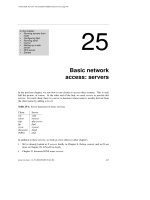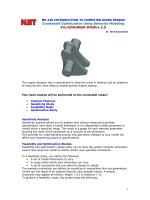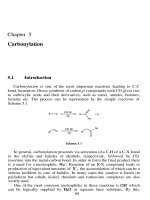Tài liệu Chapter 5 - OSI Network Layer CCNA Exploration version 4.0 ppt
Bạn đang xem bản rút gọn của tài liệu. Xem và tải ngay bản đầy đủ của tài liệu tại đây (2.15 MB, 64 trang )
Chapter 5 - OSI Network Layer
CCNA Exploration version 4.0CCNA Exploration version 4.0
Overview
• Identify the role of the Network Layer, as it describes
communication from one end device to another end device
• Examine the most common Network Layer protocol, Internet
Protocol (IP), and its features for providing connectionless and
best-effort service
• Understand the principles used to guide the division or grouping
of devices into networks
Học viện mạng Bách khoa - Website: www.bkacad.com 2
of devices into networks
• Understand the hierarchical addressing of devices and how this
allows communication between networks
• Understand the fundamentals of routes, next hop addresses and
packet forwarding to a destination network
Network Layer Protocols and Internet Protocol (IP)
Học viện mạng Bách khoa - Website: www.bkacad.com 3
• Define the basic role of the Network Layer in data networks
• The protocols of the OSI model Network layer specify addressing and
processes that enable Transport layer data to be packaged and
transported. The Network layer encapsulation allows its contents to be
passed to the destination within a network or on another network with
minimum overhead.
Network Layer – Communication from Host to Host
• Layer 3 uses four basic processes:
1. Addressing
2. Encapsulation
3. Routing: Intermediary devices that connect the networks are called
routers. The role of the router is to select paths for and direct packets
toward their destination. This process is known as routing.
4. Decapsulation
Học viện mạng Bách khoa - Website: www.bkacad.com 4
( Refer to 5.1.1 )
Network Layer Protocols
• Protocols implemented at the Network layer that carry user
data include:
– Internet Protocol version 4 (IPv4)*
– Internet Protocol version 6 (IPv6)*
Học viện mạng Bách khoa - Website: www.bkacad.com 5
– Novell Internetwork Packet Exchange (IPX).
– AppleTalk.
– Connectionless Network Service (CLNS/DECNet).
The roles of IPv4 protocol
• IPv4 is currently the most widely-used version of IP
• The Internet Protocol was designed as a protocol with low
overhead. It provides only the functions that are necessary to
deliver a packet from a source to a destination over an
interconnected system of networks.
• The protocol was not designed to track and manage the flow of
packets. These functions are performed by other protocols in
Học viện mạng Bách khoa - Website: www.bkacad.com 6
packets. These functions are performed by other protocols in
other layers.
• IPv4 basic characteristic
– Connectionless.
– Best-effort.
– Media Independent.
The IPv4 protocol – Connectionless
• Describe the implications for the use of the IP protocol
as it is connectionless.
Học viện mạng Bách khoa - Website: www.bkacad.com 7
The IPv4 protocol – Best Effort
• Describe the implications for
the use of the IP protocol as it
is considered an unreliable
protocol
• Unreliable means simply that
IP does not have the
capability to manage, and
Học viện mạng Bách khoa - Website: www.bkacad.com 8
capability to manage, and
recover from, undelivered or
corrupt packets.
• Since protocols at other
layers can manage reliability,
IP is allowed to function very
efficiently at the Network
layer.
The IPv4 protocol – Media independent
• Describe the implications for the
use of the IP as it is media
independent
• One major characteristic of the
media that the Network layer
considers: the maximum size of
PDU that each medium can
Học viện mạng Bách khoa - Website: www.bkacad.com 9
PDU that each medium can
transport. This characteristic is
referred to as the Maximum
Transmission Unit (MTU). Part of
the control communication
between the Data Link layer and
the Network layer is the
establishment of a maximum size
for the packet.
IPv4 packet – Packaging the Transport layer PD
• In some cases, an intermediary device - usually a router - will
need to split up a packet when forwarding it from one media to a
media with a smaller MTU. This process is called fragmenting the
packet or fragmentation.
Học viện mạng Bách khoa - Website: www.bkacad.com 10
IPv4 packet header
• Identify the major header fields in the IPv4 protocol
and describe each field's role in transporting packets
Học viện mạng Bách khoa - Website: www.bkacad.com 11
Network Layer Fields
Học viện mạng Bách khoa - Website: www.bkacad.com 12
• 4 bits
• Indicates version of IP used
• IPv4: 0100; IPv6: 0110
Network Layer Fields
Học viện mạng Bách khoa - Website: www.bkacad.com 13
• 4 bits
• Indicates datagram header length in 32 bit words
Network Layer Fields
Học viện mạng Bách khoa - Website: www.bkacad.com 14
• 8 bits
• Specifies the level of importance that has been
assigned by upper-layer protocol
Network Layer Fields
Học viện mạng Bách khoa - Website: www.bkacad.com 15
• 16 bits
• Specifies the length of the entire packet in bytes,
including data and header
Network Layer Fields
Học viện mạng Bách khoa - Website: www.bkacad.com 16
• 16 bits
• Identifies the current datagram
Network Layer Fields
Học viện mạng Bách khoa - Website: www.bkacad.com 17
• 3 bits(R, DF. MF)
– R(reserved): set to 0.
– DF(Don’t fragment):
• 0: Fragment if necessary.
• 1: Do not fragment.
– MF(More fragment):
• 0: This is the last fragment.
• 1: More fragment follow this fragment.
Network Layer Fields
Học viện mạng Bách khoa - Website: www.bkacad.com 18
• 13 bits
• Used to help piece together datagram
fragments
Network Layer Fields
Học viện mạng Bách khoa - Website: www.bkacad.com 19
• 8 bits
• Specifies the number of hops a packet may travel. This
number is decreased by one as the packet travels through a
router
Network Layer Fields
Học viện mạng Bách khoa - Website: www.bkacad.com 20
• 8 bits
• Indicates which upper-layer protocol, such as TCP(6) or
UDP(17), receives incoming packets after IP processing has
been completed
Network Layer Fields
Học viện mạng Bách khoa - Website: www.bkacad.com 21
• 16 bits
• Helps ensure IP header integrity
• Not caculated for the encapsulation data
Network Layer Fields
Học viện mạng Bách khoa - Website: www.bkacad.com 22
• 32 bits
• Specifies the sending node IP address
Network Layer Fields
Học viện mạng Bách khoa - Website: www.bkacad.com 23
• 32 bits
• Specifies the receiving node IP address
Network Layer Fields
Học viện mạng Bách khoa - Website: www.bkacad.com 24
• Variable length
• Allows IP to support various options, such as security
Network Layer Fields
Học viện mạng Bách khoa - Website: www.bkacad.com 25
• Variable length
• Extra zeros are added to this field to ensure that the
IP header is always a multiple of 32 bits.









